2010 Lethbrige, Alberta, Canada
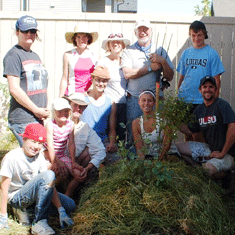
Tyson Bohnert from Lethbridge was awarded $1000 to create an on-line Neighbourhood Stewards and Nature Club mentorship program. He performed live presentations, and used different mediums of interaction including website, workshops, videos, pictures, to inform about nature related facts and issues.
Continue reading
Rain Barrels
2010 Saskatoon, Saskatchewan, Canada
 Kysha LaPlante and Dan-Elle Kramchynski from Mr. Kasun’s Grade 8 class at St. Edward School won first prize in the grade 7 to 9 category of the Caring for our Watersheds competition. The project plan developed by these two students was to decorate and supply rain barrels to participating schools in the Greater Saskatoon Catholic School Division. A total of 10 schools (plus their own school) were eager to participate in the project. The students worked together and managed to get the majority of the materials supplied in-kind from various suppliers, including the poly barrels themselves. As a result, the students only requested $150.00 from Nutrien to complete their project. Nutrien was delighted to present these students with the funds required.
Kysha LaPlante and Dan-Elle Kramchynski from Mr. Kasun’s Grade 8 class at St. Edward School won first prize in the grade 7 to 9 category of the Caring for our Watersheds competition. The project plan developed by these two students was to decorate and supply rain barrels to participating schools in the Greater Saskatoon Catholic School Division. A total of 10 schools (plus their own school) were eager to participate in the project. The students worked together and managed to get the majority of the materials supplied in-kind from various suppliers, including the poly barrels themselves. As a result, the students only requested $150.00 from Nutrien to complete their project. Nutrien was delighted to present these students with the funds required.
Kysha and Dan-Elle did a wonderful job of decorating their rain barrel, encouraging other schools to decorate their barrels as well. Students from their school were involved with decorating the final projects.
Kysha and Dan-Elle took part in a presentation at their school commemorating Earth day on April 22, 2010. During this presentation, these two students presented their school with the $1000.00 awarded to the school because of their project.
The Ripple Effect
2010 Calgary, Alberta, Canada
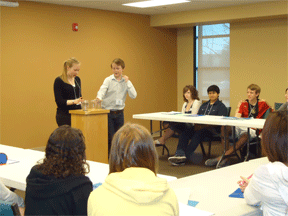
Samantha Hans wanted to raise awareness of water challenges and planned a water conference for high school students.
A Water Conference for Youth by Youth was held on Wed. May 11, 2011. The day started with an introduction of UNA-Canada and The Ripple Effect project. The Calgary Current, the Youth Advocacy Group, presented to approximately 50 high school 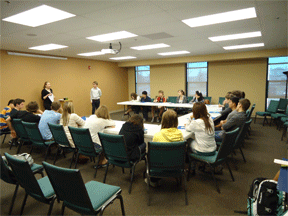 students and their teachers explaining what they do, why they do it, and why they enjoy their involvement in the project. The group of students was then split up into two groups to discuss the basics of water usage, conservation, Calgary’s Watershed and sustainability. After a quick snack the students were back to activities which included ‘water’ Family Feud, learning about the ‘water cost’ of daily items and an interactive guessing game where countries were compared based on their water usage.
students and their teachers explaining what they do, why they do it, and why they enjoy their involvement in the project. The group of students was then split up into two groups to discuss the basics of water usage, conservation, Calgary’s Watershed and sustainability. After a quick snack the students were back to activities which included ‘water’ Family Feud, learning about the ‘water cost’ of daily items and an interactive guessing game where countries were compared based on their water usage.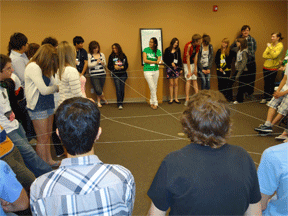
Students designed their own water sustainability t-shirts, and participated in various other learning activities including a presentation from My World, My Choice followed by three speakers with a career spin on water issues. Students were exposed to government, NGO and corporate perspectives, offering them a broader sense of career opportunities than what they would find at a career fair. Speakers included a speaker from Alberta Wilderness Association, Nutrien, and the City of Calgary. The day was filled with engaging information and new perspectives on water sustainability that the students had never heard before. Positive feedback was received from both the students and teachers who attended the conference; The Youth Advocacy Group of Calgary Current was impressed with the student’s level of engagement and immensely enjoyed their mentoring role and experience.
Water Depletion
2010 Milk River, Alberta, Canada
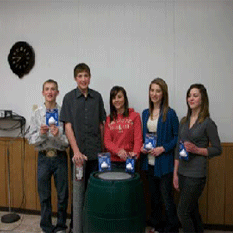
Maya Degrood from Erle River High School achieved one of the top ranks in the Grade 7 – 9 Caring for Our Watershed contest for 2010. Her plan looks at the problem of water depletion in Milk River.
Continue reading
Reduction of Water Consumption in Homes
2010 Milk River, Alberta, Canada
Tierra Maggrah from Erle Rivers High School discuss the problem of the amount of water consumption in Canadian households; her solution achieved one of the top ranks in the 2010 Caring for our Watershed Grade 7- 9 division.
Tierra Maggrah concerned about how much water the average household uses in Canada; specifically the quantity used in her community and wanted to do something about it.
Tierra knows that most people consume water by using it to maintain a nice yard, so she proposes 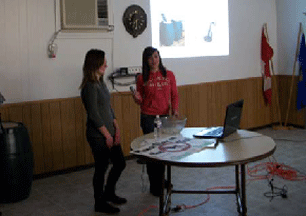 that
that
a rain barrel be placed at each home which would be used to water plants.
Her proposition of using rain barrels to obtain water as an alternative to regular tap water is a solution to reduce the consumption of water in the household.
Tierra’s implementation plan involves the purchase of 30 rain barrels, of which 3 were raffled off at the Community Stewardship Forum.
The remaining 27 rain barrels were sold at a subsidized cost at the community forum to off-set the implementation cost.

Green is Great
2010 Milk River, Alberta, Canada
Sierra Harty, from Erle River High School, won first place at the 2010 Caring for Watershed (CFW)Grade 7-9 Division.
Sierra Harty noticed the deterioration of the riverbanks leading to the water at popular canoe entry sites along the Milk River. After consulting with the County, she determined that a path made up of crushed gravel and highlighted by signs would direct the flow of recreationists to stay on the path.
The path highlighted by signs directed the flow of traffic in and out of the river at two high traffic spots: Poverty Rock and Coffin Bridge. By keeping the recreationists stay on the path, it helps minimize the deterioration of the river banks, which leads to the popular canoe entry sites along the Milk River.
She created three trail signs, and worked with the County of Warner and MRWCC to develop key messages on the trail signs. Sierra also worked on the trail sign site logistics for relevant placements on the path.

Cottonwood Tree Wrapping
2010 Milk River, Alberta, Canada
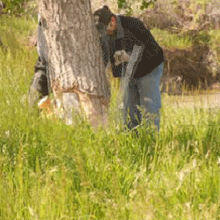
Jalen Hulit from Erle River High was in the finals for the Grade 7 -9 Division of the 2010 Caring for our Watershed (CFW).
Continue reading
Cattle Waterers
2010 Milk River, Alberta, Canada
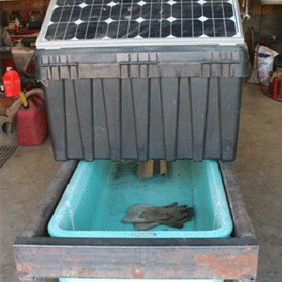
Jace Doenz and Trey Blackmer from Erle River High School were in the top ranks for the 2010 Caring for Water Shed (CFW) final.
Continue reading

Student Installs Bat Boxes and Bird Houses to Save the Bow River
2010 Calgary, Alberta, Canada
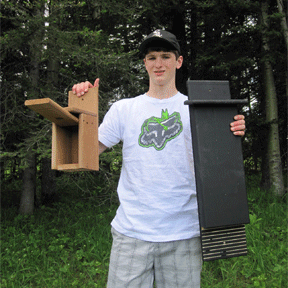
Cam Reed, a senior at Centennial High School in Calgary, Alberta won first place in the 2010 Caring for our Watersheds (CFW) finals. Afterwards, Nutrien donated $4,000 to implement his idea.
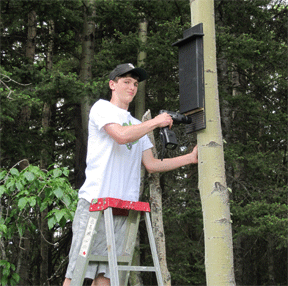
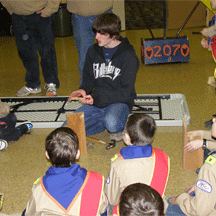
The winning idea from Reed was to install bat boxes and bird houses on golf courses in the Calgary area as a natural pest control. His proposal had a realistic budget, accurate research and a strategic timeline for implementation. By the CFW finals, Reed already had golf courses committed to the project.
Reed worked with Nutrien, 8 local golf courses and community partners such as Ducks Unlimited Canada and the Calgary Bat Society to support this project.
After selecting the boxes, Cam worked with local Boy Scouts and his High School carpentry class to paint and assemble the boxes.
The following golf courses had boxes installed: Priddis Greens Golf & Country Club, Glencoe Golf & Country Club, McKenzie Meadows Golf Club, Canyon Meadows Golf & Country Club, Maple Ridge Golf Course, Bearspaw Country Club, Canada Golf (RCGA) and Pinebrook Golf &Country Club.
Reed commented, “I’ve learned that golf courses aren’t the bad guys and they are very open to ideas to protect our watershed. And, my project was another way to add to their environmental stewardship.”
In addition to improving the watershed, Reed was offered a summer job at many of the golf courses. He accepted one and is looking forward to finishing his final year in school.
Battle River Photography Contest
2008 Strome, Alberta, Canada

Strome Junior High School students Brandon Miller and Briana Dewitz believed people would see the watershed differently when captured through the lens of a camera. Their winning Caring for our Watershed proposal idea was for a photography contest, with the winning photos being used in a calendar they would produce. The pictures were to be entered into and judged on 4 specific categories; watershed wildlife, people in nature, capture the river and the damage.
Continue reading